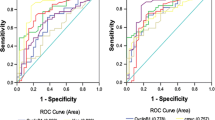Abstract
We previously reported the production of a panel of murine monoclonal antibodies which recognize glycoproteins abnormally expressed in human breast tumours. Using two of these antibodies, a double antibody radioimmunoassay was designed to quantify levels of these breast tumour marker glycoproteins in serum. Marker levels greater than 28 units were considered abnormal. Using this criterion, 63% and 75% of patients with breast cancer stages I and II, respectively, and 88% of those with metastatic disease were found to have elevated marker levels. Thirteen percent of patients with non-malignant breast disease also had elevated marker levels. Elevated marker levels were also detected in patients with non breast neoplasms. One hundred and eleven women with metastatic disease were followed. Eighty-two percent of those with progressive disease and 73% of those where disease regressed had 20% changes in marker levels. These changes in marker levels preceded by up to 6 months changes in disease state. From these results we conclude that this assay may be useful for monitoring the course of disease in breast cancer patients.
Similar content being viewed by others
Author information
Authors and Affiliations
Rights and permissions
About this article
Cite this article
Schecter, R., Major, P., Kovac, P. et al. Double antibody radioimmunoassay for monitoring metastatic breast cancer. Br J Cancer 58, 362–367 (1988). https://doi.org/10.1038/bjc.1988.220
Issue Date:
DOI: https://doi.org/10.1038/bjc.1988.220
- Springer Nature Limited
This article is cited by
-
MUC1 (CD227): a multi-tasked molecule
Cellular and Molecular Life Sciences (2015)
-
Epithelial membrane antigen expression in breast fluids and ‘witch's milk’
Breast Cancer Research and Treatment (1992)
-
CEA and CA 15-3 in primary and recurrent breast cancer
World Journal of Surgery (1990)




